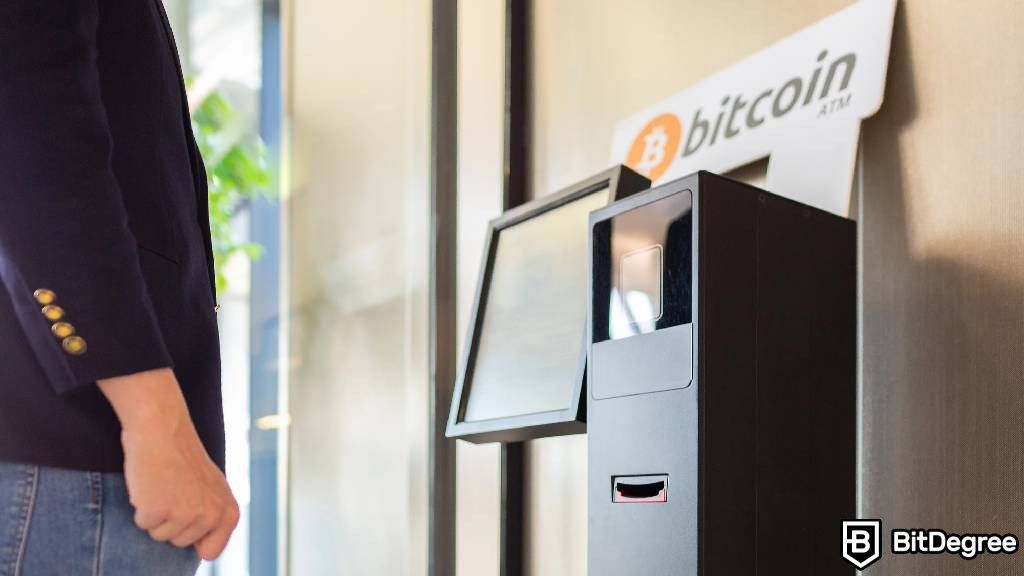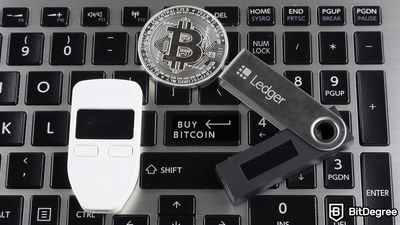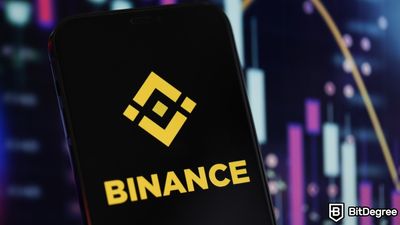Key Takeaways
- Understanding how to pay with Bitcoin provides access to lower transaction fees, enhanced security, and greater privacy;
- Knowing how to pay with Bitcoin through various methods, such as exchanges and P2P platforms, is important for maximizing the effective use of Bitcoin transactions;
- Implementing best practices for secure storage and transaction management enhances privacy and protects assets when paying with cryptocurrencies.
Stop overpaying - start transferring money with Ogvio. Join the waitlist & grab early Rewards NOW! 🎁
With millions of users worldwide, Bitcoin stands out as one of the pioneers of digital currency. As of today, numerous online retailers and brick-and-mortar stores have accepted Bitcoin as a legitimate form of payment. So, understanding how to pay with Bitcoin can open up vast financial possibilities.
As a decentralized cryptocurrency, Bitcoin offers various benefits that traditional currencies can’t match. For one, it provides an innovative and practical alternative payment method, from potentially lower transaction fees to enhanced privacy and security.
If you're wondering, “Can you even pay with crypto for daily expenses?” you’ll find the answer in this article. You’ll also learn valuable knowledge, such as how to buy Bitcoin from exchanges like Binance, Bybit, or Kraken. So, let’s get into it!

Did you know?
Subscribe - We publish new crypto explainer videos every week!
How to Store NFTs in 2023 (3 Most Secure Ways Explained)


Table of Contents
- 1. Setting Up for Bitcoin Payments
- 1.1. Getting a Crypto Wallet
- 1.2. Purchasing Bitcoin
- 2. How to Pay With Bitcoin
- 2.1. Online Payments
- 2.2. Peer-to-Peer Payments
- 2.3. In-Store Payments
- 3. Understanding Bitcoin
- 3.1. What is Bitcoin?
- 3.2. How Bitcoin Works
- 4. Benefits of Using Bitcoin for Payments
- 4.1. Potentially Cheaper Transaction Fees
- 4.2. Increased Security
- 4.3. Greater Privacy
- 5. Conclusions
Setting Up for Bitcoin Payments
Before learning how to pay with Bitcoin, you need to get a crypto wallet and buy Bitcoin. Let’s discuss it in more detail.
Latest Deal Active Right Now:Getting a Crypto Wallet
Getting a crypto wallet is the first step to starting with Bitcoin payments. There are two types of crypto wallets: hot and cold wallets. What are they?
First, hot wallets are digital wallets connected to the internet. They are typically software-based and can be accessed via smartphones, tablets, or computers.
This connectivity makes them highly convenient for regular transactions, allowing users to quickly send, receive, and manage their cryptocurrencies. Examples of hot wallets include apps like the Binance Web3 wallet and Coinbase wallet.
Now, what about cold wallets? Cold wallets are offline storage devices, such as hardware or paper wallets, that store private keys without an internet connection.
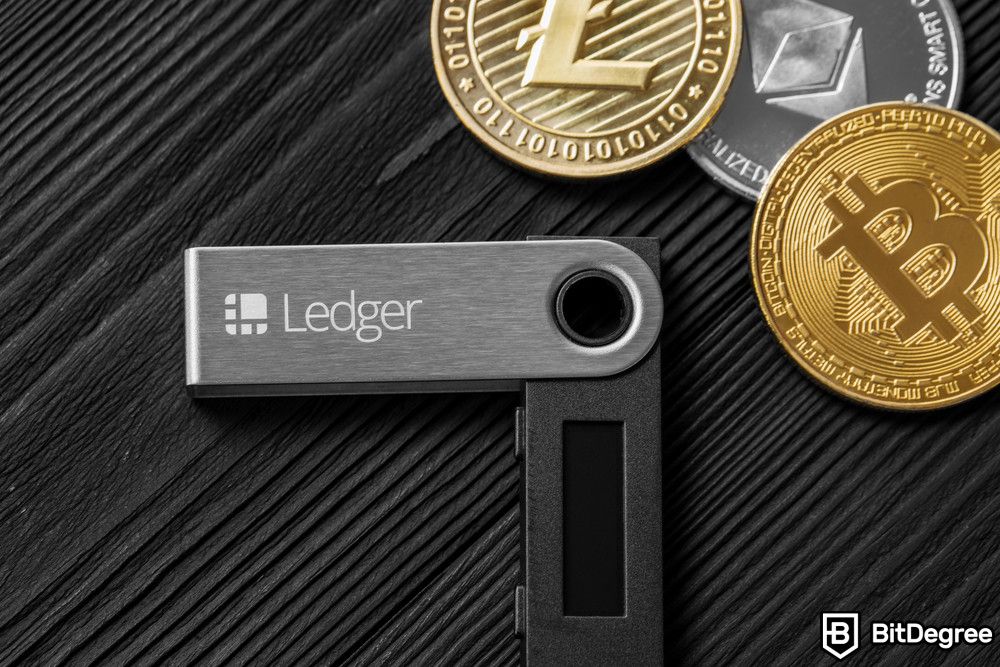
This offline status significantly enhances security, making cold wallets less vulnerable to hacking and other online threats. Hardware wallets like Ledger Nano X and Trezor Safe 5 are common examples of cold wallets, often resembling USB drives.
Understanding how to pay with Bitcoin starts with choosing the right wallet. If you're looking for one, consider the following factors:
- Security. If security is your top priority, a cold wallet is a great choice. For those who prefer convenience, a hot wallet might be more suitable.
- Usage. Consider how often you plan to use Bitcoin for transactions. A hot wallet offers convenience for frequent transactions, while a cold wallet provides better security if you plan to hold Bitcoin for a long time.
- Control. Decide if you want complete control over your private keys and funds. Hot wallets provide this control but require more responsibility from the owners.
So, whether you’re learning how to pay with cryptocurrency or looking to learn how to pay someone with crypto, getting the right crypto wallet that suits your needs is crucial.
Purchasing Bitcoin
Once you’ve set up your crypto wallet, the next step in my how to pay with Bitcoin guide is to purchase Bitcoin. There are several methods for buying Bitcoin.
First, you can purchase Bitcoin from cryptocurrency exchanges like Binance, Bybit, and Kraken. These exchanges allow you to trade fiat currency for Bitcoin, such as USD and EUR. They provide a secure environment and offer various payment options, including bank transfers and credit cards.
Another method of purchasing Bitcoin is buying from individual Bitcoin holders. You can use P2P platforms provided by Binance or Bybit to negotiate prices and payment methods with other users.
Some payment apps, like PayPal and Cash App, also support the purchase of Bitcoin. These apps are convenient and user-friendly, making them a good option for beginners.
The steps to purchase Bitcoin using each method are different. For example, I want to buy Bitcoin from Binance. Here’s a step-by-step to do so:
Step 1: Go to the Binance website or install the Binance App on your mobile phone.

Step 2: Register your email and phone number and create a password to sign up for an account. Then, complete the Know Your Customer (KYC) verification to secure your account.
Step 3: Click the [Buy Crypto] link at the top navigation menu.
Step 4: Choose your preferred fiat currency in the [Spend] field. Then, enter the amount you wish to spend. Next, click the cryptocurrency list in the [Receive] field. Select Bitcoin by searching for BTC.
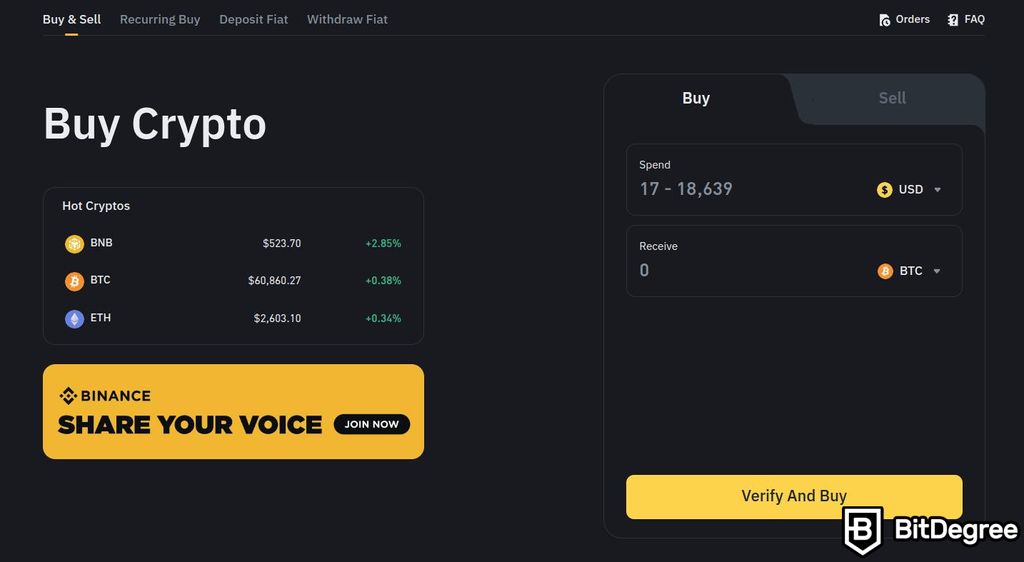
Step 5: Choose a payment method. Binance accepts various payment methods, such as debit or credit cards, Google Pay, Apple Pay, and third-party payments like Zen and Wello.
Step 6: Check the payment details and fees. You have one minute to confirm your order at the current price. After one minute passes, your order will be recalculated based on the current market price.
Step 7: Confirm the transaction. Once you’ve received Bitcoin, transfer it to your crypto wallet.
That’s it! Now, you can use the purchased Bitcoin to pay for services or products.
Before that, though, I recommend following several best practices to ensure your Bitcoin remains secure. First, always buy Bitcoin from reputable exchanges to avoid scams. Second, enhance the security of your exchange accounts by enabling two-factor authentication (2FA). Lastly, keep up with the latest security practices and updates in the cryptocurrency space.
How to Pay With Bitcoin
After setting up your wallet and purchasing Bitcoin, let’s learn how to pay with Bitcoin. Whether you want to make online purchases or pay bills with crypto, knowing how to pay with cryptocurrency will open up new possibilities.
Online Payments
Using Bitcoin as an online payment method has become increasingly common as more online retailers and services accept cryptocurrency. For those curious about “Can you pay with crypto?”, let’s find out.
So, how do you know if you can use Bitcoin as a payment method? First, find an online store or service that accepts the cryptocurrency. Many e-commerce platforms and retailers, such as Newegg, Overstock, and Shopify, accept Bitcoin. Look for Bitcoin payment logos at the checkout.
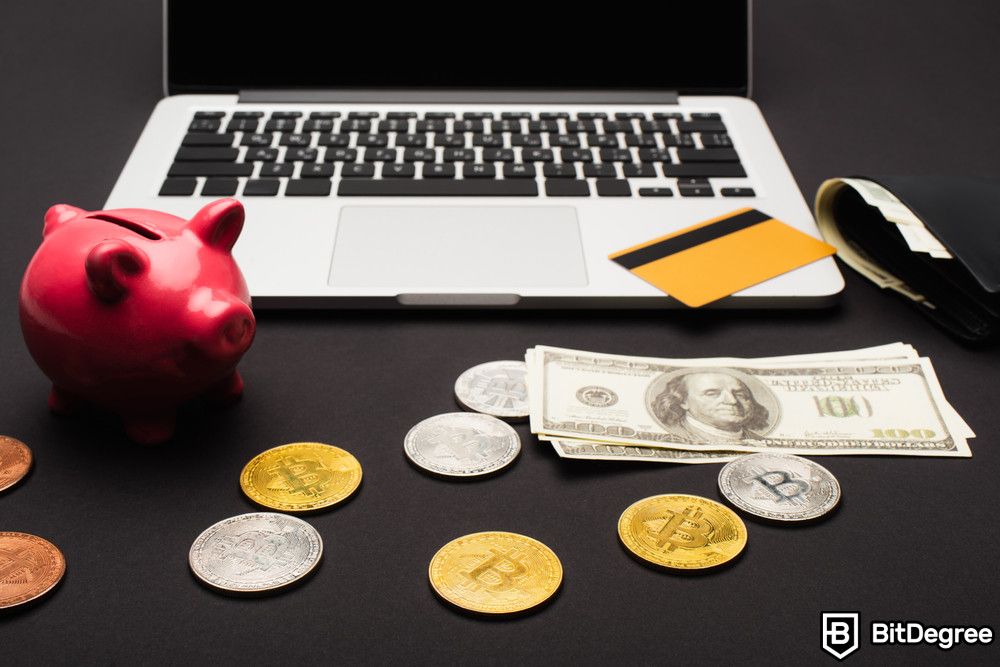
Once you’ve found one, the checkout process is usually straightforward. Here are general steps to how to pay with Bitcoin at online retailers:
Step 1: Shop as usual, adding the items you wish to purchase to your shopping cart.
Step 2: Proceed to the checkout page when you’re ready to pay.
Step 3: Choose Bitcoin or cryptocurrency as your payment method. Some stores might offer multiple cryptocurrency options.
Step 4: Scan a QR code or copy the provided Bitcoin address. This is where you’ll send your payment.
Step 5: Open your crypto wallet. Scan the QR code or paste the address, enter the payment amount, and confirm the transaction.
After the payment is sent, you’ll receive a confirmation, and your order will be processed. Congratulations! You’ve completed a Bitcoin transaction with an online retailer or e-commerce store.
If you’re wondering how to pay bills with crypto, many services allow you to do so. Websites like BitPay and CoinGate enable you to pay your utility bills, subscriptions, and other expenses directly with Bitcoin. These platforms typically provide an easy interface to complete your transaction.
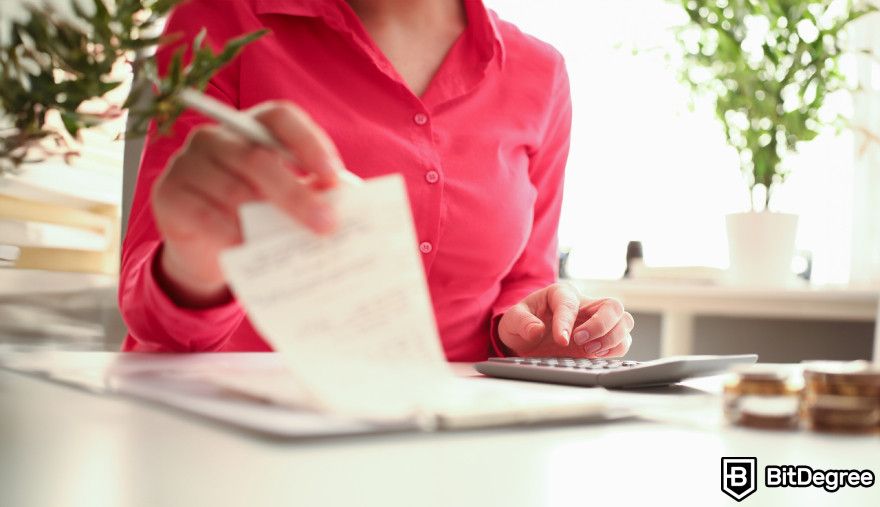
To pay bills with cryptocurrency, follow these steps:
Step 1: Choose a crypto payment platform like BitPay, CoinGate, or CryptoRefills, which converts your crypto to fiat for bill payments.
Step 2: Connect your wallet (like Coinbase or Metamask) to the platform.
Step 3: Choose the type of bill (utilities, rent, phone, etc.) and enter the required details.
Step 4: Send the payment by scanning a QR code or entering a crypto address. The platform converts and pays the bill in fiat.
Step 5: Check for fees, get payment confirmation, and keep records for tracking.
Some companies may accept direct crypto payments. By the way, it's better to use stablecoins instead of Bitcoin to avoid volatility.
Peer-to-Peer Payments
Another common question regarding Bitcoin for payments is, “Can you pay with crypto using P2P payments?" The short answer is yes. By the way, a peer-to-peer (P2P) transaction is ideal for those looking for a quick, potentially low-cost, and worldwide transaction method.
Suppose you're working with a client, and he or she asks for Bitcoin as payment. To understand how to pay someone with crypto, I'll explain how to send Bitcoin using the Binance mobile app as an example. Follow the steps below:
Step 1: Open your Binance app on your mobile phone and tap the [Pay] button at the top-right corner of the screen. Just note that you must pass KYC beforehand.

Step 2: Tap [Send] on the Pay screen.

Step 3: Paste or enter the recipient's Binance ID or email address and tap [Continue]. Ensure the ID or email address is correct, as Bitcoin transactions are irreversible.
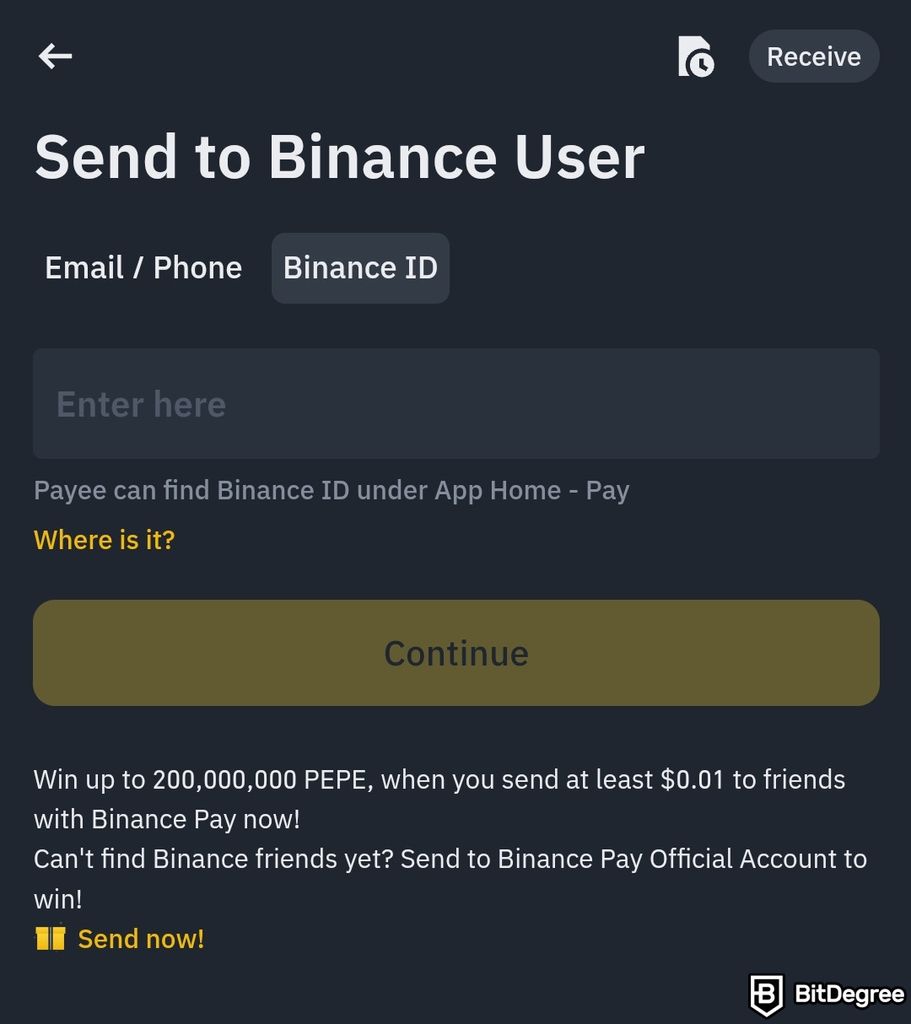
Step 4: Select Bitcoin or BTC from the drop-down list and specify the amount of Bitcoin you wish to send. Then, tap [Confirm].
Step 5: Review the transfer and gas fee. Check the transaction details carefully before tapping [Confirm].
Step 6: Verify the Bitcoin transfer. Wait for the transaction to be processed.
Some wallets, including Binance wallet, allow you to generate QR codes or payment links for Bitcoin payment requests. This feature simplifies the payment request process, as the recipient can simply scan the QR code or click the link to complete the transaction. This is especially useful for businesses or individuals who frequently receive payments in Bitcoin.
Additionally, P2P Bitcoin transactions offer several advantages:
- Fast settlement times. Unlike international bank transfers that take 1 to 3 business days, Bitcoin P2P transactions are typically confirmed within minutes to hours.
- Lower fees. Bitcoin transaction fees can be potentially cheaper than traditional international P2P payment services, as they depend on transaction size and network congestion.
- Global reach. Bitcoin can be sent to anyone, anywhere in the world, as long as the recipients have a crypto wallet.
However, it’s important to know any tax implications or regulations that might apply to your Bitcoin transactions. Bitcoin is often subject to capital gains tax. Additionally, regulations regarding cryptocurrency can vary, so I recommend staying informed about these aspects in your region.
Knowing how to pay someone with crypto can greatly enhance your ability to conduct transactions efficiently. P2P Bitcoin payments offer a flexible option if you’re learning how to pay with Bitcoin for individual services, such as freelancers. But remember that you should understand the considerations and limitations of this option.

Did you know?
Subscribe - We publish new crypto explainer videos every week!
Is Your Crypto Safe? (5 Best Crypto Security Practices Explained)


In-Store Payments
While using Bitcoin for in-store purchases has become a common thing, there are still some limitations. Many physical stores don’t accept Bitcoin due to the volatility of crypto prices and the complexity of integrating crypto payments into existing systems.
Some stores that accept cryptocurrency as a payment method use the point-of-sales (POS) system. With the integration of POS, customers can purchase items with crypto by scanning a QR code or tapping their smartphone at the checkout. This is similar to mobile payment apps, and it’s convenient for customers who prefer cryptocurrency.
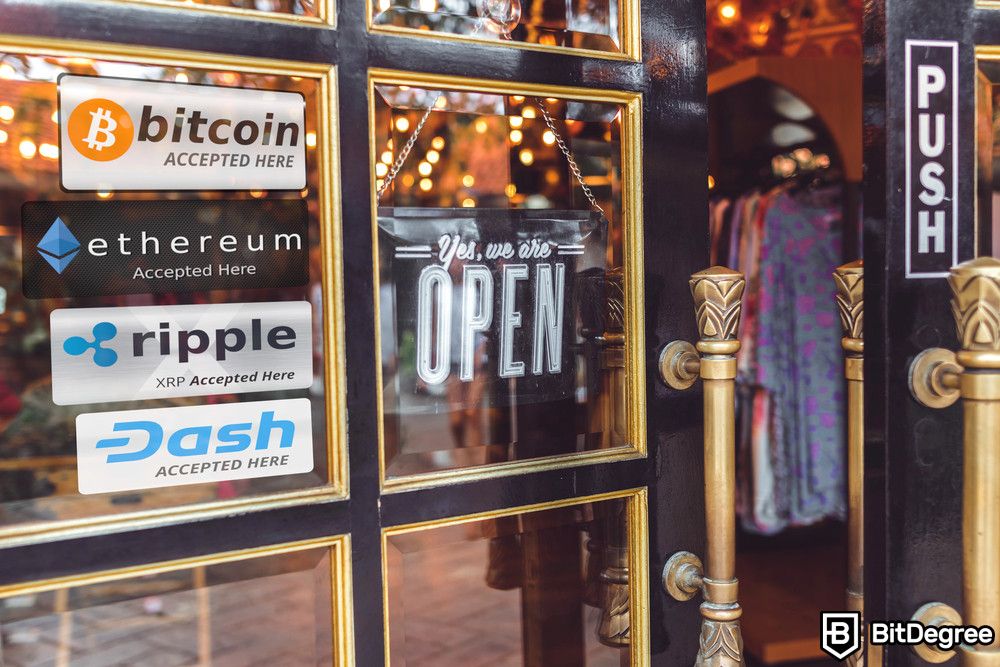
For example, here are the typical steps on how to pay Bitcoin in stores:
Step 1: Select the items you wish to purchase and proceed to the checkout.
Step 2: Inform the cashier that you want to pay with cryptocurrency like Bitcoin.
Step 3: Scan the QR code with your crypto wallet app. The QR code includes the payment amount in the cryptocurrency you want to use.
Step 4: Enter the payment amount and confirm the transaction in your wallet app.
That’s it! After the transaction is processed, you’ll receive confirmation on your wallet app that the payment has been made successfully.
Crypto debit cards are another way to spend Bitcoin in physical stores that accept crypto payments. These cards are issued by companies and exchanges like Bybit, Coinbase, and others. They allow you to fund cryptocurrency, so you can use it at any store that accepts traditional debit or credit cards. When you make a purchase, Bitcoin is converted into fiat currency in real time.
While cryptocurrency adoption for in-store purchases is still growing, these solutions make it increasingly feasible. So, if you’re wondering, “Can you pay with crypto in a store?” the answer is yes, especially with the help of POS systems and crypto debit cards.
Understanding Bitcoin
Now you know how to pay with Bitcoin for different transactions. While Bitcoin is renowned as the most popular cryptocurrency, some might still wonder what it is and how it operates. So, let’s discuss the basics of this digital currency.
If you already know all that, skip to the next chapter to learn more about the benefits of paying with Bitcoin. Though, if you continue with this chapter, you might learn something new about the asset.
What is Bitcoin?
Bitcoin is a digital currency that operates on a decentralized network, free from any central authority or government control. It was first launched in 2009 by the pseudonymous Satoshi Nakamoto. This cryptocurrency has transformed the way we perceive and use money.
Bitcoin relies on public-private key cryptographic technologies to control and transfer funds[1]. Public keys allow anyone to send funds to an address, while private keys are used to sign transactions and authorize the spending of Bitcoin.
In public-key cryptography, when a message is encrypted with a recipient's public key, only the holder of the matching private key can decrypt and read it. This ensures secure communication. Conversely, when a private key is used to sign a message, anyone with the corresponding public key can verify that the message came from the key's owner, ensuring authenticity.

Overall, Bitcoin is different from traditional or fiat currencies because it is:
- Decentralized. Unlike traditional currencies, Bitcoin isn’t regulated by any central bank or financial institution. So, transactions are verified by network nodes through cryptography and recorded on a public ledger called the blockchain network.
- Secure. Since Bitcoin transactions are secured through cryptographic techniques, it’s extremely difficult for unauthorized parties to alter the data.
- Limited supply. Bitcoin's fixed supply is capped at 21 million coins. This scarcity is built into the system to prevent inflation and preserve its value over time.
These characteristics contribute to Bitcoin’s unique position in the digital finance world. Since its launch, Bitcoin’s use cases have expanded. Initially, it was primarily used for peer-to-peer (P2P) transactions, allowing individuals to send and receive payments without intermediaries.
Nowadays, Bitcoin is widely accepted by various online retailers and even some physical stores. People use Bitcoin for everything from buying coffee to paying for services like freelancers.
How Bitcoin Works
To understand how Bitcoin works, let’s start with its foundation – blockchain technology. A blockchain is a decentralized digital ledger that records all Bitcoin transactions across a network of computers. This ledger is maintained by numerous nodes, ensuring that every transaction is transparent, immutable, and secure.
Each block in the blockchain contains a list of transactions, and once a block is filled, it forms a chain by linking to the previous one. This process makes it nearly impossible to alter past transactions, which is why Bitcoin has a high level of security.
At the heart of Bitcoin’s operation is the mining process. Bitcoin mining is a decentralized process that verifies transactions and adds them to the public ledger or blockchain[2]. This is where new Bitcoins are created, and transactions are confirmed.

To interact with the Bitcoin network, users need a crypto wallet. As I mentioned before, this wallet lets you store, send, and receive cryptocurrencies. Additionally, each wallet offers different levels of security and convenience.
Overall, understanding these fundamental aspects of Bitcoin is essential for anyone looking to use it for everyday transactions. This knowledge will help you navigate digital finance, including how to pay with Bitcoin effectively.
Benefits of Using Bitcoin for Payments
Using Bitcoin and other cryptocurrencies for payments offers several advantages over traditional methods. From lower transaction fees to enhanced privacy, understanding the benefits of how to pay with Bitcoin provides an alternative payment method for your daily transactions.
Potentially Cheaper Transaction Fees
One benefit of using Bitcoin and other cryptocurrencies for payment is the potential for lower transaction fees. That’s because traditional payment methods like credit cards and bank transfers often have high processing fees.
For instance, credit card companies typically charge merchants a fixed fee per transaction and a percentage of the transaction amount, usually ranging from 1.5% to 3.5%. Similarly, banks may charge fees for wire transfers and other payment services, which can add up, especially for international transactions.
In contrast, crypto transactions can bypass these intermediaries, potentially leading to much lower fees. When you learn how to pay with Bitcoin, you’ll notice that transactions are processed directly between the sender and the recipient without banks or credit card firms. This way, crypto transactions eliminate fees associated with traditional payment methods.
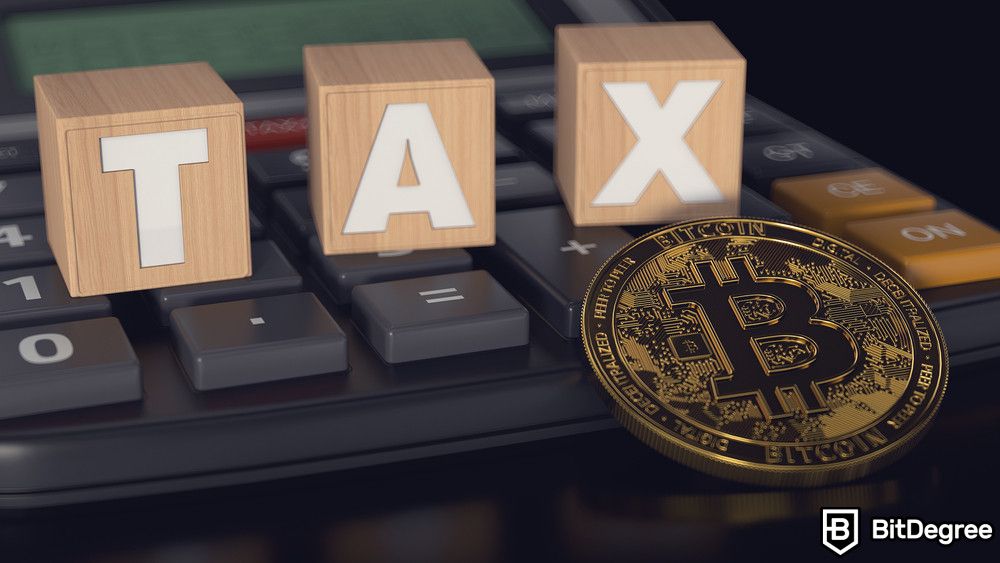
Additionally, P2P transactions play a crucial role in reducing costs. When you send Bitcoin directly to another person’s wallet, you don’t need to worry about transaction fees from intermediaries.
This can be especially beneficial for international payments, where traditional bank transfer fees are relatively high. For instance, someone figuring out how to pay someone with crypto for a service or product in a different country might find it significantly cheaper than using a traditional bank transfer.
Moreover, many businesses have saved money by accepting Bitcoin. For instance, Overstock, one of the first retailers to accept Bitcoin, reported significant savings on transaction fees compared to credit card payments.
Increased Security
Unfortunately, there are many security risks associated with traditional payment methods. These include fraud before and after the payment process, malware attacks, and phishing scams.
Bitcoin transactions, on the other hand, are secured because they implement advanced cryptographic techniques and blockchain technology. Each transaction is verified by network nodes and recorded on a decentralized public ledger. The blockchain’s immutability ensures that once a transaction is confirmed, it can’t be changed or reversed.
Cryptographic keys also improve the security of cryptocurrency transactions. Each crypto wallet has a public key for receiving funds and a private key for signing transactions. This cryptographic security ensures that only the wallet owner can authorize payments.
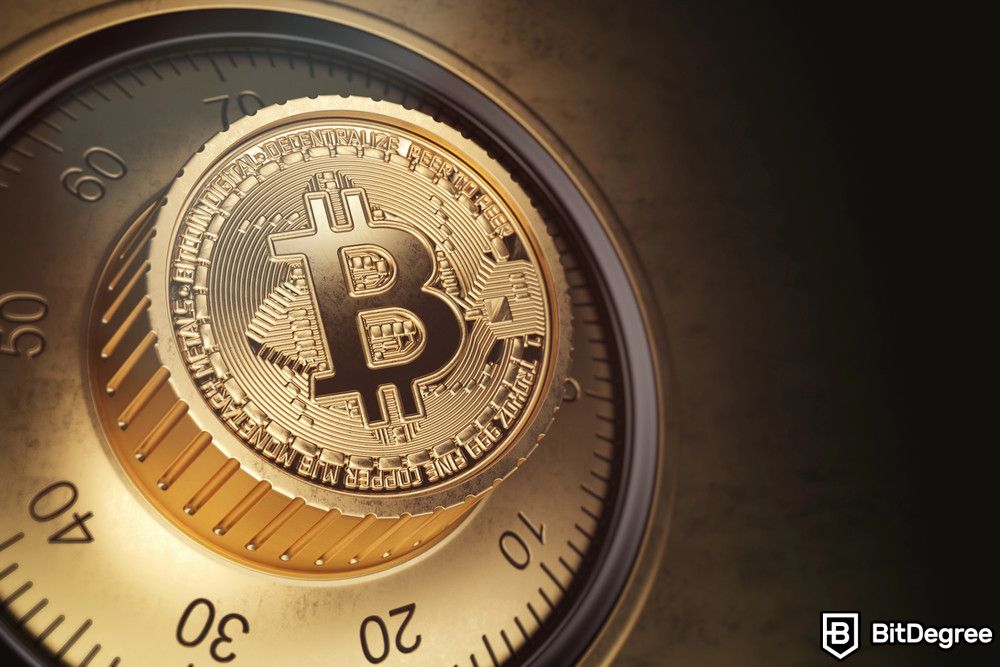
However, the security of crypto transactions also depends on the secure storage of crypto wallets. Users must implement best practices to protect their wallets from loss or theft. This includes using hardware wallets like Ledger Nano X, enabling 2FA, and regularly backing up the wallet.
So, it’s important to know these security features and practices, for example, if you’re learning how to pay bills with crypto. This knowledge can provide peace of mind, and you can enhance the safety of your crypto transactions.

- Secure and reliable
- Accepts fiat currencies
- Lots of trading options
- Reputable exchange
- Accepts fiat currencies
- Offers various trading options

- Huge trading variety
- Regulation-compliant around the globe
- Fair trading fees
- Beginner-friendly
- A wide array of features
- Vast number of different crypto coins & tokens

- Beginner-friendly
- Secure
- Decent trading and withdrawal fees
- Crypto.com Visa Card
- Automated tools & bots
- Ecosystem synergy with CRO
Greater Privacy
Understanding the privacy aspects of Bitcoin and other cryptocurrencies is crucial for anyone considering how to pay with Bitcoin. Privacy in cryptocurrency can be categorized into anonymity and pseudonymity.
Anonymity means the transactions are untraceable, so neither the sender nor the receiver’s details are exposed. Pseudonimity, however, means that transactions are linked to pseudonyms like Bitcoin addresses, which can be traced back to real identities if sufficient external data is available.
Bitcoin operates on a pseudonymous model. When you conduct a transaction, your Bitcoin address, derived from your private key, is visible on the blockchain. If the address is reused or linked to personal information through exchanges or other services requiring identity verification, it can potentially be traced back to you.
To enhance privacy, I recommend using different Bitcoin addresses for multiple transactions. This practice makes linking multiple transactions back to a single user more challenging. Some wallets, such as Ledger Nano X and Coinbase wallet, offer a feature to generate new addresses for each transaction.

Compared to Bitcoin, some cryptocurrencies are specifically designed to offer enhanced anonymity. For instance, Monero (XMR) uses ring signatures and stealth addresses to obscure sender and receiver details. There is also Zcash (ZEC), which employs zero-knowledge proofs to hide transaction amounts and participants.
By the way, a zero-knowledge proof (ZKP) is a cryptographic method that enables one party (the prover) to prove to another party (the verifier) that a statement is true without disclosing any further information. This ensures the verifier is convinced of the truth without learning anything beyond the validity of the statement itself.
These privacy-focused cryptocurrencies provide a higher level of confidentiality but may face regulatory scrutiny due to concerns about their potential use in illicit activities.
Conclusions
In conclusion, understanding how to pay with Bitcoin offers numerous new opportunities in digital finance. Also, using Bitcoin provides several advantages over traditional payment methods, including potentially lower transaction fees, enhanced security, and greater privacy.
Setting up Bitcoin payments involves choosing the right wallet, purchasing Bitcoin, and learning the various methods of how to pay with Bitcoin. Whether you’re making online purchases, conducting P2P transactions, or paying bills, knowing how to pay with cryptocurrency will enable you to navigate the digital finance landscape effectively.
Moreover, Bitcoin’s decentralized nature and cryptographic security provide robust protection against fraud and unauthorized transactions. However, to safeguard your assets, it’s essential to implement best practices for secure storage and transaction management. For instance, you can use a hardware wallet like Ledger Nano X, which offers enhanced security features.
As the adoption of Bitcoin and other cryptocurrencies continues to grow, its benefits become more apparent, making it an attractive alternative to traditional payment methods. By staying informed about the latest developments and best practices in the crypto space, you can maximize Bitcoin’s potential and enjoy a secure, efficient, and private payment experience.
The content published on this website is not aimed to give any kind of financial, investment, trading, or any other form of advice. BitDegree.org does not endorse or suggest you to buy, sell or hold any kind of cryptocurrency. Before making financial investment decisions, do consult your financial advisor.
Scientific References
1. Böhme, Rainer, N. Christin, et al: ‘Bitcoin: Economics, Technology, and Governance’;
2. S. Küfeoğlu, M. Özkuran, et al: ‘Bitcoin mining: A global review of energy and power demand’.
